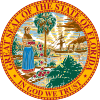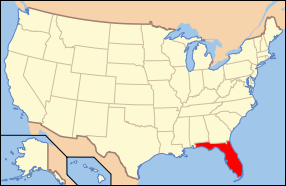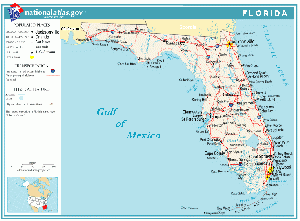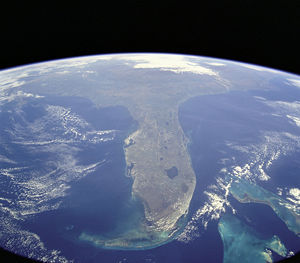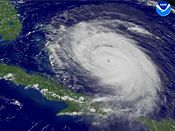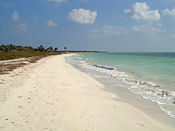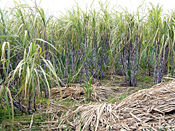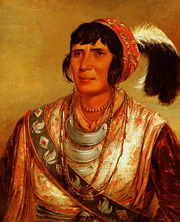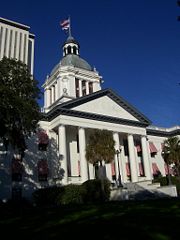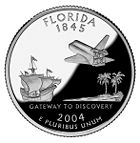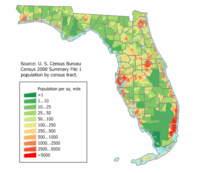Florida
| State of Florida | |||||||||||
| |||||||||||
| Official language(s) | English[1] | ||||||||||
| Spoken language(s) | English 76.9% Spanish 16.5%[2] | ||||||||||
| Capital | Tallahassee | ||||||||||
| Largest city | Jacksonville | ||||||||||
| Largest metro area | South Florida metropolitan area | ||||||||||
| Area | Ranked 22nd | ||||||||||
| - Total | 65,755[3] sq mi (170,304[3] km²) | ||||||||||
| - Width | 361 miles (582 km) | ||||||||||
| - Length | 447 miles (721 km) | ||||||||||
| - % water | 17.9 | ||||||||||
| - Latitude | 24° 27′ N to 31° 00' N | ||||||||||
| - Longitude | 80° 02′ W to 87° 38′ W | ||||||||||
| Population | Ranked 4th in the U.S. | ||||||||||
| - Total | 19,057,542 (2011 est)[4] | ||||||||||
| - Density | 353/sq mi (136/km2) Ranked 8th in the U.S. | ||||||||||
| - Median income | $47,778 (33rd) | ||||||||||
| Elevation | |||||||||||
| - Highest point | Britton Hill[5][6] 345 ft (105 m) | ||||||||||
| - Mean | 100 ft (30 m) | ||||||||||
| - Lowest point | Atlantic Ocean[5] 0 ft (0 m) | ||||||||||
| Admission to Union | March 3, 1845 (27th) | ||||||||||
| Governor | Rick Scott (R) | ||||||||||
| Lieutenant Governor | Jennifer Carroll (R) | ||||||||||
| U.S. Senators | Bill Nelson (D) Marco Rubio (R) | ||||||||||
| Time zones | |||||||||||
| - Peninsula and "Big Bend" region | Eastern: UTC-5/-4 | ||||||||||
| - Panhandle | Central: UTC-6/-5 | ||||||||||
| Abbreviations | FL Fla. US-FL | ||||||||||
| Web site | www.myflorida.com | ||||||||||
The State of Florida is located in the southeastern region of the United States. Most of the state is a large peninsula bordered by the Gulf of Mexico on its west and the Atlantic Ocean on its east.
Florida is the fourth most populated state in the United States, following California, Texas, and New York. This rise in population was caused by a large influx of people moving from other parts of the country, drawn by the climate, as well as the immigration of Cubans, Haitians, and others fleeing political and economic difficulties.
Florida's modern history, like much of America's, was one of conflict and subjugation. It was discovered by Spanish explorers in the fifteenth century and alternately ruled by France and England. Exploited for power and wealth, Native Americans and Europeans struggled for control of the land until the nineteenth century. After Florida became a state in 1845, the struggle over slavery continued to mark its history. In the mid-nineteenth century more than 40 percent of Florida's population were slaves.
Florida is a state of contrasts, home to St. Augustine, the oldest continuously inhabited European settlement on the North American continent, and the Kennedy Space Center, home to the United States space program. It is home to the world's largest vacation resort Walt Disney World Resort. Its climate and beaches attract 60 million visitors every year, but poverty is widespread. Housing and traffic congestion and a high crime rate confront the state. The need for land and water for its growing population is pitted against the need to preserve the environment.
Geography
Florida is situated mostly on a large peninsula between the Gulf of Mexico, the Atlantic Ocean, and the Straits of Florida. It extends to the northwest into a panhandle, extending along the northern Gulf of Mexico. Alabama and Georgia form its northern border. To the west, its panhandle is bordered by Alabama. The islands of the Caribbean, particularly the Bahamas and Cuba lie close to its eastern and southern shores.
Florida has the third longest shoreline of any of the United States followed by Michigan and Alaska.
The Florida peninsula is a porous plateau of karst limestone sitting atop bedrock. Extended systems of underwater caves, sinkholes, and springs are found throughout the state and supply most of the water used by residents. The limestone is topped with sandy soils deposited as ancient beaches over millions of years as global sea levels rose and fell. During the last Ice Age, lower sea levels and a drier climate revealed a much wider peninsula, largely desert. At the southern end of the peninsula, the Everglades are in fact an enormously wide, very slow-flowing river.
At 345 feet (105 m) above mean sea level, Britton Hill is the highest point in Florida and the lowest state highpoint among the fifty U.S. states.[7] Much of the interior of Florida, typically 25 miles (40 km) or more away from the coastline, features hills with elevations ranging from 100 to 250 feet (30 – 76 m) in many locations.
Climate
The climate of Florida is tempered somewhat by its proximity to water. Most of the state has a humid subtropical climate, except for the southern part below Lake Okeechobee, which has a true tropical climate. Cold fronts can occasionally bring high winds and cool to cold temperatures to the entire state during late fall and winter. The seasons in Florida are determined more by precipitation than by temperature, with mild to cool, relatively dry winters and autumns (the dry season) and hot, wet springs and summers (the wet season). The Gulf Stream has a moderating effect on the climate, and although much of Florida commonly sees a high summer temperature over 90°F (32°C), the mercury seldom exceeds 100°F (38°C). The Florida Keys, being surrounded by water, have a more tropical climate, with less variability in temperatures.
Although Florida's nickname is the "Sunshine State," severe weather is a common occurrence. Central Florida is known as the lightning capital of the United States, as it experiences more strikes than anywhere else in the country. Florida has the highest average precipitation of any state, in large part because afternoon thunderstorms are common in most of the state from late spring until early autumn. These thunderstorms, caused by collisions between airflow from the Gulf of Mexico and the Atlantic Ocean, pop up in the early afternoon and can bring heavy downpours, high winds, and sometimes tornadoes. Florida leads the United States in tornadoes per square mile, but these tornadoes do not typically reach the intensity of those in the Midwest and Great Plains. Hail often accompanies the most severe thunderstorms.
Snow is a rare occurrence. During the Great Blizzard of 1899, Florida experienced blizzard conditions. The most widespread snowfall in Florida history happened on January 19, 1977, when snow fell over much of the state in different times of the month. Snow flurries fell on Miami Beach for the only time in recorded history.
Although some storms have formed out of season, tropical cyclones pose a severe threat during hurricane season, which lasts from June 1 to November 30. Florida is the most hurricane-prone U.S. state, with subtropical or tropical water on three sides and a lengthy coastline. It is rare for a hurricane season to pass without any impact in the state by at least a tropical storm.
Fauna
Florida is host to many types of wildlife including:
- Marine Mammals : Bottlenose Dolphin, Pilot Whale, Northern Right Whale, Manatee
- Reptiles: Alligator, Crocodile, Eastern Diamondback and Pygmy Rattlesnakes, Gopher Tortoise, Green & Leatherback Sea Turtles, Indigo Snake
- Mammals: Panther, Whitetail Deer, Key Deer, Bobcats, Southern Black Bear, Armadillos
- Birds: Bald Eagle, Crested Caracara, Snail Kite, Osprey, Pelicans, Sea Gulls, Whooping and Sandhill Cranes, Roseate Spoonbill, Florida Scrub Jay (endemic), and many more.
Florida is also a winter home for most species of eastern North American birds.
Its plant life includes eleven types of palms, as well as beech, cypress, pine, and mangrove.
Environmental issues
Florida ranks forty-fifth in total energy consumption per capita, despite the heavy reliance on air conditioners and pool pumps. This includes coal, natural gas, petroleum, and retail electricity sales.[8] It is estimated that approximately 4 percent of energy in the state is generated through renewable resources. Florida's energy production is 6.0 percent of the nation's total energy output, while total production of pollutants is lower, with figures of 5.6 percent for nitrogen oxide, 5.1 percent for carbon dioxide, and 3.5 percent for sulfur dioxide.[9]
It is believed that significant petroleum resources are located off Florida's western coast in the Gulf of Mexico, but that region has been closed to offshore exploration by law since 1981.
In 2006, the state enacted a "Farm to Fuel" initiative, an effort to increase production of renewable energy from crops, agricultural wastes, and residues produced in the state of Florida. In January 2008, Florida's Agriculture and Consumer Services Commissioner announced funding for four commercial ethanol and biodiesel production facilities, and an additional eight demonstration and research projects.[10]
In July 2007, Florida Governor Charlie Crist announced plans to sign executive orders that would impose strict new air pollution standards in the state, with aims to reduce greenhouse-gas emissions by 80 percent of 1990 levels by 2050.[11]
Florida obtains much of its drinking water from the Floridan Aquifer and the Biscayne Aquifer, as well as from surface water from Lake Okeechobee and other lakes, but population increases have begun to strain available sources. The state has built 120 desalination plants, more than three times as many as any other state,[12] including the largest plant in the United States.[13] Additionally, an electrodialysis reversal plant in Sarasota is the largest of its type in the world, [14] and a nanofiltration plant in Boca Raton is the largest of its type in the western hemisphere.[12]
Increasing landfill space is also an issue. St. Lucie County is planning to experiment with burning trash through plasma arc gasification to generate energy and reduce landfill space. The experiment will be the largest of its kind in the world to date, and begin operation no later than 2009.[15]
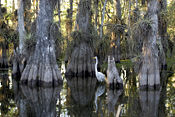 Everglades National Park in southern Florida. |
History
Archaeological research indicates that Florida had been inhabited as early as twelve thousand years ago. Of the many indigenous peoples, the largest known were the Ais, the Apalachee, the Calusa, the Timucua and the Tocobago tribes. These tribes were largely wiped out by disease or removed by the Spanish. Later, members of other tribes to the north moved into Florida and became known as the Seminoles.
Juan Ponce de León, a Spanish conquistador, named Florida in honor of his discovery of the land on April 2, 1513, during Pascua Florida, a Spanish term for the Easter season. The land became known as "La Florida." (Juan Ponce de León may not have been the first European to reach Florida; according to one report, at least one indigenous tribesman whom he encountered in 1513 spoke Spanish.[16]
Over the following century, both the Spanish and French established settlements in Florida, with varying degrees of success. In 1559, Spanish Pensacola was established by Don Tristán de Luna y Arellano as the first European settlement in the continental United States, but it had been abandoned by 1561 and would not be reinhabited until the 1690s. French Huguenots founded Fort Caroline in modern-day Jacksonville in 1564, but the fort was conquered by forces from the new Spanish colony of Saint Augustine the following year.
The Spanish never had a firm hold on Florida, and maintained tenuous control over the region by converting the local tribes, briefly with Jesuits and later with Franciscan friars.
The area of Spanish Florida diminished with the establishment of English colonies to the north and French colonies to the west. The English weakened Spanish power in the area by supplying their Creek allies with firearms and urging them to raid the Timucuan and Apalachee, client-tribes of the Spanish. The English also attacked St. Augustine, burning the city and its cathedral to the ground several times.
The Spanish, meanwhile, encouraged slaves to flee the English-held Carolinas and come to Florida, where they were converted to Roman Catholicism and given freedom. They settled in a buffer community north of Saint Augustine, called Gracie Real de Santa Teresa de Mose, the first completely black settlement in what would become the United States.
Great Britain gained control of Florida diplomatically in 1763 through the Peace of Paris. Britain divided the colony into East Florida, with its capital at St. Augustine, and West Florida, with its capital at Pensacola. Britain tried to develop the Floridas through the importation of immigrants for labor, including some from Minorca and Greece, but this project ultimately failed. Spain regained the Floridas after Britain's defeat by the American colonies and the subsequent Treaty of Versailles in 1783. It offered land grants to anyone who settled in the colonies, and many Americans moved to them. This Americanization resulted, by terms of the Adams-Onís Treaty of 1819, in Spain ceding Florida to the United States in exchange for the Americans' renunciation of any claims on Texas and $5 million.
The Seminole Wars
The U.S. Army led increasingly frequent incursions into Spanish territory to recapture escaped slaves, including the 1817–1818 campaign against the Seminole Indians by Andrew Jackson that became known as the First Seminole War. Following the war, the United States effectively controlled East Florida.
Once the United States acquired Florida in 1819, Jackson was named military governor. As American settlement increased, pressure grew on the federal government to remove the Indians from their lands in Florida so settlers could have access to them. Slave owners also wanted the fugitive slaves living among the Seminoles returned to slavery.
In the 1830s, thousands of Seminoles were forcibly removed from their homelands and forced to march to Indian Territory in Oklahoma, joining what became known as the Trail of Tears. In 1832, the U.S. government signed the Treaty of Paynes Landing with a few of the Seminole chiefs, promising them lands west of the Mississippi River if they agreed to leave Florida voluntarily. The remaining Seminoles prepared for war. In 1835, the U.S. Army arrived to enforce the treaty. Seminole leader Osceola led the vastly outnumbered resistance during the Second Seminole War. To survive, the Seminole allies employed hit-and-run guerrilla tactics with devastating effect against U.S. forces. Osceola was arrested when he came under a flag of truce to negotiations in 1837. He died in jail less than one year later.
Other war chiefs continued the Seminole resistance. The war ended, after a full decade of fighting, in 1842. Many Native Americans were forcibly exiled to Creek lands west of the Mississippi River. Others retreated into the Everglades. The war ended when the United States government abandoned attempts to subjugate the Seminole tribe, leaving a population of less than 100 Seminoles in peace. The Seminoles never surrendered to the United States government and are the only tribe never to sign a formal peace treaty with the United States.
Statehood
On March 3, 1845, Florida became the 27th state of the United States of America. Its population grew slowly. By 1860 it had only 140,424 people, of whom 44 percent were enslaved. There were fewer than 1,000 free people of color before the Civil War.[17]
On January 10, 1861, before the formal outbreak of the American Civil War, Florida seceded from the Union; ten days later, the state became a founding member of the Confederate States of America. The war ended in 1865. On June 25, 1868, Florida's congressional representation was restored.
Until the mid-twentieth century, Florida was the least populous southern state. The climate, tempered by the growing availability of air conditioning, and low cost of living made the state a haven. Migration from the Rust Belt and the Northeast sharply increased the population. Economic prosperity combined with Florida's sudden elevation in profile led to the Florida land boom of the 1920s, which brought a brief period of intense land development before the Great Depression brought it all to a halt.
Florida's economy did not fully recover until World War II. With an estimated population of more than 18 million, Florida is the most populous state in the Southeast, the second most populous state in the South behind Texas, and the fourth most populous in the United States. The Census Bureau estimates that Florida may edge past New York into third place in total population by 2011.[18][19]
Government
The rough-hewn frontier capital, Tallahassee, gradually grew into a town during Florida's territorial period (1821-1845). It became the capital of Florida in 1824. The Marquis de Lafayette, French hero of the American Revolution, returned for a grand tour of the United States in 1824. The U.S. Congress voted to give him $200,000 (the same amount he had given the colonies in 1778), U.S. citizenship, and a plot of land that currently makes up a portion of the city of Tallahassee. In 1845, a Greek revival masonry structure was erected as the Capitol building in time for statehood. Now known as the "old Capitol," it stands in front of the Capitol highrise building, which was constructed in the 1970s.
The basic structure, duties, function, and operations of the government of the State of Florida are defined and established by the Florida Constitution, which establishes the basic law of the state and guarantees various rights and freedoms of the people. The state government consists of three separate branches: judicial, executive, and legislative. The legislature enacts bills, which, if signed by the governor, become Florida Statutes.
The Florida legislature comprises the Senate, which has 40 members, and the House of Representatives, which has 120 members.
There are 67 counties in Florida, but some reports show only 66 because of Duval County, which is consolidated with the City of Jacksonville.
Florida was traditionally a Democratic state; at one time, 68.5 percent of all Floridians were registered Democrats. In the last decades of the twentieth century, the realignment of the "Solid South" has led many conservative Democrats of Florida to vote with the Republican Party. This tendency, combined with explosive population growth, which has brought many Republicans into the state as well as Cuban immigration, has given Florida a Republican edge in practice. As a result, Republicans control the governorship and most other statewide elective offices: both houses of the state legislature, 16 of the state's 25 seats in the House of Representatives, and one of the state's two Senate seats. Because of the state's population and number of electoral votes, political analysts consider it to be a key swing state in presidential elections, which became obvious during the 2000 election when Florida played a key role in the election.
Economy
The gross state product of Florida in 2005 was $596 billion. Its GDP is one of the fastest-growing in the nation, with a 7.7 percent increase from 2004 to 2005. Personal income was $30,098 per capita, ranking 26th in the nation.[20]
Tourism makes up the largest sector of the state economy. Warm weather and hundreds of miles of beaches attract about 60 million visitors every year. Amusement parks, especially in the Orlando area, make up a significant portion of tourism. The Walt Disney World Resort is the largest vacation resort in the world, consisting of four theme parks and more than 20 hotels in Lake Buena Vista; it, and Universal Orlando Resort, Busch Gardens, SeaWorld, and other major parks drive state tourism. Many beach towns are also popular tourist destinations, particularly in the winter months.
The second largest industry is agriculture. Citrus fruit, especially oranges, are a major part of the economy, and Florida produces the majority of citrus fruit grown in the U.S. – in 2006 67 percent of all citrus, 74 percent of oranges, 58 percent of tangerines, and 54 percent of grapefruit. About 95 percent of commercial orange production in the state is destined for processing, mostly as orange juice, the official state beverage.[21] Citrus canker continues to be an issue of concern. Other products include sugarcane and celery.[22] The environmental impact of agriculture, especially water pollution, is a major issue in Florida today. In the late twentieth and early twenty-first centuries a multimillion-dollar effort was undertaken to restore the ecosystem of the Everglades.
Phosphate mining is the state's third-largest industry. The state produces about 75 percent of the phosphate required by farmers in the United States and 25 percent of the world supply, with about 95 percent used for agriculture (fertilizer and livestock feed supplements) and 5 percent for other products.[23]
Since the arrival of the NASA Merritt Island launch sites on Cape Canaveral (most notably Kennedy Space Center) in 1962, Florida has developed a sizable aerospace industry.
In addition, the state has seen a recent boom in medical and bio-tech industries throughout its major metropolitan areas. Orlando was recently chosen as the official site for the new headquarters of the Burnham Institute, a major bio-tech and medical research company.
The state was one of the few states to not have a state minimum wage law until 2004, when voters passed a constitutional amendment establishing a state minimum wage and (unique among minimum wage laws) mandating that it be adjusted for inflation every six months.
Historically, Florida's economy was based upon cattle farming and agriculture (especially sugarcane, citrus, tomatoes, and strawberries). In the early 1900s, land speculators discovered Florida, and businessmen such as Henry Plant and Henry Flagler developed railroad systems, which led people to move in, drawn by the weather and local economies. From then on, tourism boomed, fueling a cycle of development that overwhelmed a great deal of farmland.
In 2004 and 2005, key industries along the west coast—commercial fishing and water-based tourist activities (sports fishing and diving)—were threatened by outbreaks of red tide, a discoloration of seawater caused by an efflorescence of toxin-producing dinoflagellates.
Florida is one of the nine states that do not impose a personal income tax. The state had imposed a tax on "intangible personal property" (stocks, bonds, mutual funds, money market funds, etc.), but this tax was abolished after 2006.
Demographics
Population
Florida has the fourth highest state population in the United States. As of 2006, Florida's population was 18,089,888; an increase of 2,107,510 (over 13 percent) from 2000. The state grew 321,647, or 1.8 percent from 2005.
Religion
Florida is mostly Protestant, with a Roman Catholic community that is growing because of immigration; it is now the single largest denomination in the state. There is also a sizable Jewish community, located mainly in South Florida; no other Southern state has such a large Jewish population. Florida's religious affiliations as of 2008 are shown in the table below:[24]
- Christian, 81 percent
- Protestant, 54 percent
- Baptist, 19 percent
- Methodist, 6 percent
- Presbyterian, 4 percent
- Episcopal, 3 percent
- Lutheran, 3 percent
- Pentecostal, 3 percent
- Other Protestant, 16 percent
- Roman Catholic, 26 percent
- Mormon – 1 percent
- Protestant, 54 percent
- Jewish, 4 percent
- other religions, 1 percent
- non-religious, 14 percent
Languages
As of 2000, 76.91 percent of Florida residents age 5 and older spoke only English at home as a first language, while 16.46 percent spoke Spanish, and French-based creole languages (predominantly Haitian Creole) was spoken by 1.38 percent of the population. French was spoken by 0.83 percent, followed by German at 0.59 percent, and Italian at 0.44 percent of all residents.[25]
Florida's climate makes it a popular state for immigrants. Florida's public education system identifies over 200 first languages other than English spoken in the homes of students. In 1990, the League of United Latin American Citizens (LULAC) won a class action lawsuit against the state Department of Education that required educators to be trained in teaching English for speakers of other languages.
Article II, Section 9, of the Florida Constitution provides that "English is the official language of the State of Florida." This provision was adopted in 1988 by a vote following an Initiative Petition.
Ancestry Groups
The largest reported ancestries in the 2000 census were German (11.8 percent), Irish (10.3 percent), English (9.2 percent), American (8 percent), Italian (6.3 percent), French (2.8 percent), Polish (2.7 percent), and Scottish (1.8 percent).[26]
Before the American Civil War, when slavery was legal, and during the Reconstruction era that followed, African Americans made up nearly half of the state's population.[27] Their proportion declined over the next century, as many moved north in the Great Migration while large numbers of northern whites moved to the state. Recently, the state's proportion of black residents has begun to grow again. Today, large concentrations of black residents can be found in northern Florida (notably in Jacksonville, Gainesville, and Pensacola), the Tampa Bay area, the Orlando area, and South Florida (where their numbers have been bolstered by significant immigration from Haiti and Jamaica).
Florida's Hispanic population includes large communities of Cuban Americans in Miami and Tampa, Puerto Ricans in Tampa and Orlando, and Central American migrant workers in inland west-central and south Florida.
Whites of all ethnicities are present in all areas of the state. Those of British and Irish ancestry are present in large numbers in all the urban/suburban areas across the state. There is a large German population in southwest Florida, a large Greek population in the Tarpon Springs area, a sizable and historic Italian community in the Miami area, and white Floridians of longer-present generations in the culturally southern areas of inland and northern Florida. Native white Floridians, especially those who have descended from long-time Florida families, affectionately refer to themselves as "Florida crackers." Like all the other southern states, they descend mainly from Scots-Irish as well as some British settlers.
Looking to the future
Florida's geography, location and tropical and subtropical climates are its best natural resources and a major influence on the state's economy. The state produces the bulk of the country’s citrus fruit and is famous for its oranges. In addition, its grapefruit production is the highest in the U.S. and represents a large proportion of the world total.
The largest single portion of the state’s economy is derived from the services industry, mainly related to tourism, again due to its climate and proliferation of beaches. Walt Disney Resort is the largest vacation resort in the world. Sixty million visitors come to the state each year.
Its location has also drawn immigrants to the state, mainly in the form of northern retirees and refugees from South and Central America. Its tourism figures coupled with its rise in population has also fostered construction, transportation, and real estate economy.
The state is socially progressive, and much of its financial resources are dedicated to education, social welfare, health, and hospitals. There is an array of assistance programs for the disabled, elderly, and families with dependent children, as well as for refugees, those with addiction problems, the homeless, and mentally ill. However, public welfare payments are among the lowest in the nation. In total personal income, Florida ranks among the top states nationally, and ranks near the middle in income per capita. While unemployment normally runs below the national average, poverty continues to be widespread.
Florida is faced with the difficulties of a burgeoning population—growing congestion, a high crime rate, and pressures on the environment. A multimillion-dollar effort is under way to undo the mistakes of the past and restore the ecosystem of the Everglades. While its climate, beaches, and location near the Caribbean guarantee a positive economic future, these same features pose challenges as the state's leaders must find a positive and equitable balance between advantaged and disadvantaged, and both use and preservation of the environment.
Notes
- ↑ Article 2, Section 9, Constitution of the State of Florida. State of Florida. Retrieved February 4, 2012.
- ↑ Florida - Languages Retrieved February 4, 2012.
- ↑ 3.0 3.1 2000 Census (ZIP). US Census Bureau. Retrieved February 4, 2012.
- ↑ Error on call to template:cite web: Parameters url and title must be specified (CSV). 2011 Population Estimates. United States Census Bureau, Population Division (December 2011).
- ↑ 5.0 5.1 Elevations and Distances in the United States. United States Geological Survey (2001). Retrieved October 21, 2011.
- ↑ Elevation adjusted to North American Vertical Datum of 1988.
- ↑ Roger Johnson. Florida, the Sunshine State Welcome to America. Retrieved October 16, 2008.
- ↑ United States Department of Energy. Energy Consumption by Source and Total Consumption per Capita, Ranked by State, 2004 Retrieved October 16, 2008.
- ↑ US Department of Energy. State Energy Profiles: Florida Retrieved October 16, 2008.
- ↑ Florida Department of Agriculture and Consumer Services. 2008 Farm to Fuel Grants Program Winners Retrieved October 16, 2008.
- ↑ Jim Loney, July 12, 2007. Florida To Introduce Tough Greenhouse Gas Targets Environmental News Network. Retrieved October 16, 2008.
- ↑ 12.0 12.1 Cynthia Barnett, May 1, 2007. Salty Solution? Florida Trend Magazine. Retrieved October 16, 2008.
- ↑ Tampa Bay Online. December 22, 2007. Applause, At Last, For Desalination Plant Retrieved October 16, 2008.
- ↑ Eugene R. Reahl. Half a Century of Desalination with Electrodialysis General Electric.
- ↑ USA Today, September 9, 2006. Florida county plans to vaporize landfill trash Retrieved October 16, 2008.
- ↑ Hale G. Smith, and Marc Gottlob. 1978. "Spanish-Indian Relationships: Synoptic History and Archaeological Evidence, 1500-1763." In Tacachale: Essays on the Indians of Florida and Southeastern Georgia during the Historic Period, Edited by Jerald Milanich and Samuel Proctor. (Gainesville, Florida: University Presses of Florida. ISBN 0813005353).
- ↑ University of Virginia Library. Historical Census Browser.
- ↑ U.S. Census Bureau. August 09, 2007. Florida, California and Texas to Dominate Future Population Growth, Census Bureau Reports.
- ↑ United States Census Bureau. United States population by states Retrieved October 17, 2008.
- ↑ Bureau of Economic Analysis. October 26, 2006.Advance Estimates of GDP by State for 2005 by NAICS Sector Retrieved October 17, 2008.
- ↑ Hayley Boriss, February 2006. Commodity Profile: Citrus Agricultural Issues Center, University of California. Retrieved October 17, 2008.
- ↑ USDA. Crop Profile for Celery in Florida NSF Center for Integrated Pest Management, North Carolina State University. Retrieved October 17, 2008.
- ↑ Mosiac. About Phosphate.
- ↑ The Pew Forum on Religion & Public Life. Religious Composition of Florida Retrieved October 17, 2008.
- ↑ MLA Language Map Data Center. Most spoken languages in Florida in 2005 Retrieved October 17, 2008.
- ↑ U.S. Census Bureau. Florida Factstreet Retrieved October 17, 2008.
- ↑ U.S. Census Bureau. Compendium of the Ninth Census: Population, with race, (14) Retrieved October 17, 2008.
ReferencesISBN links support NWE through referral fees
- Chang, Perry. Florida. New York: Marshall Cavendish, 1998. ISBN 0761404201
- Heinrichs, Ann. Florida. New York: Children's Press, 1998. ISBN 051620632X
- Orr, Tamra B. Florida. New York: Children's Press, 2008. ISBN 978-0531185582
External links
All links retrieved March 28, 2024.
- Florida travel official site
- Official portal of the State of Florida
- Everglades National Park
- Florida Memory Project Over 300,000 photographs and documents from the State Library & Archives of Florida.
- Online collection of the Spanish Land Grants.
| Political divisions of the United States | |||||||
|---|---|---|---|---|---|---|---|
| |||||||
Credits
New World Encyclopedia writers and editors rewrote and completed the Wikipedia article in accordance with New World Encyclopedia standards. This article abides by terms of the Creative Commons CC-by-sa 3.0 License (CC-by-sa), which may be used and disseminated with proper attribution. Credit is due under the terms of this license that can reference both the New World Encyclopedia contributors and the selfless volunteer contributors of the Wikimedia Foundation. To cite this article click here for a list of acceptable citing formats.The history of earlier contributions by wikipedians is accessible to researchers here:
The history of this article since it was imported to New World Encyclopedia:
Note: Some restrictions may apply to use of individual images which are separately licensed.

